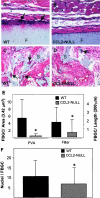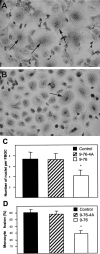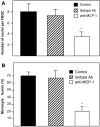The CC chemokine ligand, CCL2/MCP1, participates in macrophage fusion and foreign body giant cell formation
- PMID: 15579457
- PMCID: PMC1618731
- DOI: 10.1016/S0002-9440(10)63265-8
The CC chemokine ligand, CCL2/MCP1, participates in macrophage fusion and foreign body giant cell formation
Abstract
The foreign body reaction (FBR) develops in response to the implantation of almost all biomaterials and can be detrimental to their function. The formation of foreign body giant cells (FBGC), which damage the surface of biomaterials, is considered a hallmark of this reaction. FBGC derive from blood-borne monocytes that enter the implantation site after surgery in response to the release of chemotactic signals. In this study, we implanted biomaterials subcutaneous (s.c.) in mice that lack the monocyte chemoattractant CC chemokine ligand 2 (CCL2) and found that biomaterials were encapsulated despite reduced FBGC formation. The latter was due to compromised macrophage fusion rather than migration. Consistent with the reduction in FBGC formation, biodegradable biomaterials sustained reduced damage in CCL2-null mice. Furthermore, blockade of CCL2 function by localized gene delivery in wild-type mice hindered FBGC formation, despite normal monocyte recruitment. The requirement for CCL2 in fusion was confirmed by the ability of both a CCL2 inhibitory peptide and an anti-CCL2 Ab to reduce FBGC formation from peripheral blood monocytes in an in vitro assay. Our findings demonstrate a previously unreported involvement of CCL2 in FBGC formation, and suggest that FBGC are not the primary determinants of capsule formation in the FBR.
Figures







Similar articles
-
CCL2 and CCR2 are Essential for the Formation of Osteoclasts and Foreign Body Giant Cells.J Cell Biochem. 2016 Feb;117(2):382-9. doi: 10.1002/jcb.25282. J Cell Biochem. 2016. PMID: 26205994
-
In vivo quantitative and qualitative assessment of foreign body giant cell formation on biomaterials in mice deficient in natural killer lymphocyte subsets, mast cells, or the interleukin-4 receptorα and in severe combined immunodeficient mice.J Biomed Mater Res A. 2014 Jun;102(6):2017-23. doi: 10.1002/jbm.a.35152. Epub 2014 Mar 19. J Biomed Mater Res A. 2014. PMID: 24616384
-
Cellular and microenvironmental cues that promote macrophage fusion and foreign body response.Front Immunol. 2024 Jul 5;15:1411872. doi: 10.3389/fimmu.2024.1411872. eCollection 2024. Front Immunol. 2024. PMID: 39034997 Free PMC article.
-
A call for standardization: Evaluating different methodologies to induce in vitro foreign body giant cell formation for biomaterials research and design.Acta Biomater. 2025 Mar 1;194:20-37. doi: 10.1016/j.actbio.2025.01.026. Epub 2025 Jan 16. Acta Biomater. 2025. PMID: 39826854 Review.
-
Formation and biological activities of foreign body giant cells in response to biomaterials.Acta Biomater. 2024 Oct 15;188:1-26. doi: 10.1016/j.actbio.2024.08.034. Epub 2024 Sep 7. Acta Biomater. 2024. PMID: 39245307 Review.
Cited by
-
Multi-nucleated giant cell formation from human cord blood monocytes in vitro, in comparison with adult peripheral blood monocytes.Clin Exp Immunol. 2009 Oct;158(1):84-90. doi: 10.1111/j.1365-2249.2009.03990.x. Clin Exp Immunol. 2009. PMID: 19737234 Free PMC article.
-
Biocompatibility of implants: lymphocyte/macrophage interactions.Semin Immunopathol. 2011 May;33(3):221-33. doi: 10.1007/s00281-011-0244-1. Epub 2011 Jan 27. Semin Immunopathol. 2011. PMID: 21271251 Review.
-
Macrophage fusion, giant cell formation, and the foreign body response require matrix metalloproteinase 9.J Leukoc Biol. 2009 Apr;85(4):617-26. doi: 10.1189/jlb.1008588. Epub 2009 Jan 13. J Leukoc Biol. 2009. PMID: 19141565 Free PMC article.
-
Loss of monocyte chemoattractant protein-1 alters macrophage polarization and reduces NFκB activation in the foreign body response.Acta Biomater. 2015 Jan;11:37-47. doi: 10.1016/j.actbio.2014.09.022. Epub 2014 Sep 19. Acta Biomater. 2015. PMID: 25242651 Free PMC article.
-
Nanoparticle delivery of miR-223 to attenuate macrophage fusion.Biomaterials. 2016 May;89:127-35. doi: 10.1016/j.biomaterials.2016.02.036. Epub 2016 Feb 26. Biomaterials. 2016. PMID: 26967647 Free PMC article.
References
-
- Mikos AG, McIntire LV, Anderson JM, Babensee JE. Host response to tissue engineered devices. Adv Drug Deliv Rev. 1998;33:111–139. - PubMed
-
- Tang L, Eaton JW. Inflammatory responses to biomaterials. Am J Clin Pathol. 1995;103:466–471. - PubMed
-
- Woodward SC. How fibroblasts and giant cells encapsulate implants: considerations in design of glucose sensors. Diabetes Care. 1982;5:278–281. - PubMed
-
- Ratner BD. New ideas in biomaterials science: a path to engineered biomaterials. J Biomed Mater Res. 1993;27:837–850. - PubMed
Publication types
MeSH terms
Substances
Grants and funding
LinkOut - more resources
Full Text Sources
Other Literature Sources
Molecular Biology Databases

